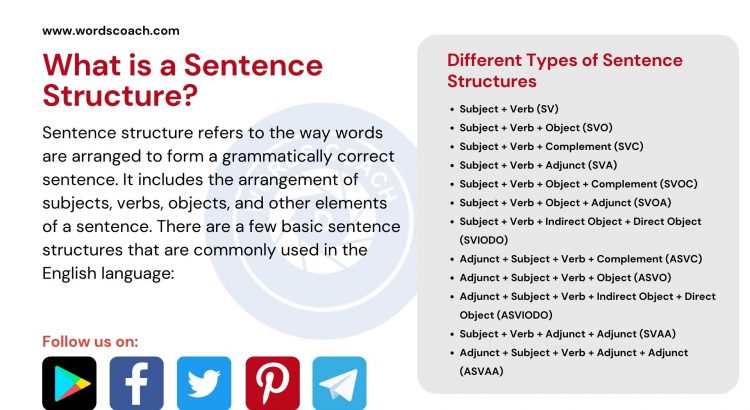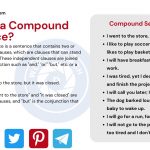Sentence structure refers to the way words are arranged to form a grammatically correct sentence. It includes the arrangement of subjects, verbs, objects, and other elements of a sentence. There are a few basic sentence structures that are commonly used in the English language:
- Simple sentence: A simple sentence has one independent clause and one subject-verb combination. Example: “The cat sat on the mat.”
- Compound sentence: A compound sentence has two or more independent clauses connected by a conjunction. Example: “The cat sat on the mat, but the dog lay on the floor.”
- Complex sentence: A complex sentence has one independent clause and one or more dependent clauses. The dependent clauses provide additional information about the independent clause. Example: “The cat sat on the mat, because it was tired.”
- Compound-Complex sentence: A sentence that contains at least two independent clauses and one or more dependent clauses. Example: “The cat sat on the mat, because it was tired, but the dog lay on the floor, because it was lazy.”
In general, a well-structured sentence should be clear, concise, and easy to understand. Sentences should also be constructed in a logical and coherent order, with proper punctuation and grammar.
Basic Parts and Components of a Sentence
Before we look into how sentence structure works, we will have to first learn about the basic structure of a sentence and the components that make up a sentence.
Parts of a Sentence
The parts of a sentence are the individual building blocks that make up a grammatically correct sentence. The main parts of a sentence are:
- Subject: The subject is the person, place, or thing that the sentence is about. It is typically the noun or pronoun that performs the action of the sentence. Example: “The cat (subject) sat on the mat.”
- Verb: The verb is the action or state of being that the subject performs. It is the main part of the predicate. Example: “The cat sat (verb) on the mat.”
- Object: The object is the noun or pronoun that receives the action of the verb. It is typically found after the verb. Example: “The cat sat on (object) the mat.”
- Complement: A complement is a word or a phrase that is used to provide additional information about the subject or the object. Example: “The cat is (complement) black.”
- Adverbial: An adverbial is a word or phrase that modifies a verb, adjective or another adverb, and provides information about time, place, reason, or manner. Example: “The cat sat quietly (adverbial) on the mat.”
- Adjective: An adjective is a word that modifies a noun or pronoun, providing additional information about its characteristics. Example: “The cat sat on the soft (adjective) mat.”
- Prepositional phrase: A prepositional phrase is a group of words that begins with a preposition and modifies a noun or pronoun. Example: “The cat sat on (prepositional phrase) the mat.”
These are the main parts of a sentence, but depending on the sentence, others could be added, such as conjunctions, interjections etc. Understanding the basic parts of a sentence and how they work together can help you to write clear and grammatically correct sentences.
The Different Types of Sentence Structures in English Grammar
- Subject + Verb (SV)
- Subject + Verb + Object (SVO)
- Subject + Verb + Complement (SVC)
- Subject + Verb + Adjunct (SVA)
- Subject + Verb + Object + Complement (SVOC)
- Subject + Verb + Object + Adjunct (SVOA)
- Subject + Verb + Indirect Object + Direct Object (SVIODO)
- Adjunct + Subject + Verb + Complement (ASVC)
- Adjunct + Subject + Verb + Object (ASVO)
- Adjunct + Subject + Verb + Indirect Object + Direct Object (ASVIODO)
- Subject + Verb + Adjunct + Adjunct (SVAA)
- Adjunct + Subject + Verb + Adjunct + Adjunct (ASVAA)

Examples of Sentence Structure
Here are some examples of different sentence structures:
- Simple sentence: “The dog barked.” (one independent clause and one subject-verb combination)
- Compound sentence: “The dog barked at the mailman, but the cat slept on the couch.” (two independent clauses connected by a conjunction)
- Complex sentence: “The dog barked at the mailman because he was scared.” (one independent clause and one dependent clause)
- Compound-complex sentence: “The dog barked at the mailman because he was scared, but the cat slept on the couch because it was tired.” (two independent clauses and one dependent clause)
- Compound-complex sentence with adjectives and adverbials : “The clever dog barked loudly at the mailman, because he was scared, but the tired cat slept quietly on the soft couch.”
- Compound-complex sentence with adjective and prepositional phrase : “The clever dog barked loudly at the mailman, who was in uniform, but the tired cat slept quietly on the soft couch in the living room.”
It’s worth noting that, sentence structures can be more complex than these examples, but the basic principles are the same. The main thing to keep in mind is that a sentence should be clear, concise and easy to understand. And the different parts of a sentence should be used correctly and in the right order.





